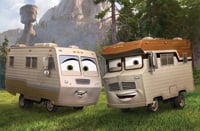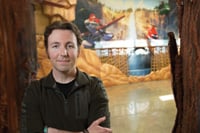 Quite a few movies have featured motorhomes, but I think the two best I’ve seen are Lost in America and About Schmidt. Certainly none is funnier than Lost in America, the 1985 classic by Albert Brooks in which a couple give up their jobs, buy a Winnebago to travel, lose their nest egg in Las Vegas and face cruel reality. None is more heartfelt than 2002’s About Schmidt, with Jack Nicholson giving a brilliant performance as a lost soul on an RV trip.
Quite a few movies have featured motorhomes, but I think the two best I’ve seen are Lost in America and About Schmidt. Certainly none is funnier than Lost in America, the 1985 classic by Albert Brooks in which a couple give up their jobs, buy a Winnebago to travel, lose their nest egg in Las Vegas and face cruel reality. None is more heartfelt than 2002’s About Schmidt, with Jack Nicholson giving a brilliant performance as a lost soul on an RV trip.
There’s another movie with RVs coming out July 18, and since I have not yet seen it, I can’t tell you how good it is, but I have seen the motorhomes in it, and they are adorable.
Motorhomes Harvey and Winnie aren’t the lead characters but have nice supporting roles in Disney’s animated feature, Planes: Fire and Rescue. The first thing you notice about Harvey and Winnie is that, although well-maintained, they have some miles on them. These are not sleek new aerodynamic models with multiple slideouts, but motor coaches whose styling was fresh in the 1970s.
The movie’s director, Bobs Gannaway (not a typo, his first name really is Roberts, or Bobs), said when you make a movie with talking vehicles, you want them to be age-appropriate for the characters. Harvey and Winnie have come to Piston Peak National Park to celebrate their 50th wedding anniversary. Comedic actors Jerry Stiller and Anne Meara were chosen by Gannaway to serve as voices for the characters because, like Harvey and Winnie, they have been married to each other for a long time (well over 50 years in their case). Gannaway said he wanted voices that felt “authentic and real, not cartoony.”
As to the choice of names, Winnie, of course, echoes the Winnebago brand and Harvey is not that far from RV.
Harvey has a reddish brown top that is kind of like the reddish hair that Stiller had when he was younger. Harvey’s grill represents the mustache that Stiller always sports. There is a hint of eyeglasses in the bars that are attached to the sides of the coaches and that frame the windshield. Harvey and Winnie are motorhomes that move kind of slow, like people nearing their 50th wedding anniversary.
In Disney animation, the attention to detail goes down to the point of making sure the tires look right, with the correct distribution of air, whether a vehicle is moving or standing still.
Planes: Fire and Rescue is a sequel to last year’s Planes and part of a franchise that began with the highly popular Cars movie. The hero in Planes was Dusty Crophopper, a crop-dusting plane (voiced by Dane Cook) that was the upset winner of an air race around the world. Now, in the sequel, Dusty’s racing days are over and he has to find a new purpose in life.
 We chatted by phone with Gannaway and Toby Wilson, the movie’s art director, and what came through was the careful attention to realistic detail in animated movies that most of us think of as only fantasy.
We chatted by phone with Gannaway and Toby Wilson, the movie’s art director, and what came through was the careful attention to realistic detail in animated movies that most of us think of as only fantasy.
The theme of Planes: Fire and Rescue was inspired by the devastating fires at Yosemite National Park in 1988, and the idea of what would happen during a fire when campers are trapped and there is only one road out. Gannaway and Wilson worked on the movie for four years and as part of their preparation, they and their team spent time with firefighters at training centers for Cal Fire, the California state agency that fights forest fires with air tankers, helicopters, bulldozers and lots of manpower. Gannaway said one goal of the movie is to “shine the light on the bravery and courage of these firefighters.”
The setting for the main action, Piston Peak National Park, has features you may recognize from Yellowstone and Yosemite. Wilson, who grew up in Phoenix in a family that went camping in a popup tent camper, drew on his own camping experience for the film. There is a lodge based on the Old Faithful Lodge at Yellowstone with elements from a lodge at Glacier National Park. Wilson made sure the campground is realistic, with cars, tents and Class B and Class C motorhomes as well as the Class A Harvey and Winnie.
 Aviation and firefighting experts served as technical consultants to make sure that the depictions were realistic.
Aviation and firefighting experts served as technical consultants to make sure that the depictions were realistic.
Why so much attention to realism in a movie that transports us to a land of fantasy? The realistic details are part of what draws us into that world, and helps us accept the notion of talking motorhomes and airplanes with feelings.
As Gannaway explains, “You may not notice these things, but you would notice if they weren’t there.”
It wouldn’t be a Disney animated movie if it didn’t impart lessons for youngsters. In this case, we learn the value of second chances in life, and that aviation and firefighting can be exciting careers. There might even be a boost for the RV industry here, and a reminder to everyone of the importance and beauty of national parks and the joy to be found in camping.
Write to Mike Ward, editor at RV Life magazine, 18717 76th Avenue West, Suite B, Lynnwood, WA 98037 or e-mail editor@rvlife.com. Find “First Glance” online at rvlife.com.

Lets not forget, Harvey and Winnie would be turned out on their a**** at alot of campgrounds now because of pompus 500k rv owners and 10yr rule grounds. After all their not classy or shiney enough for the current generation of rolling snobs. Too bad 🙁